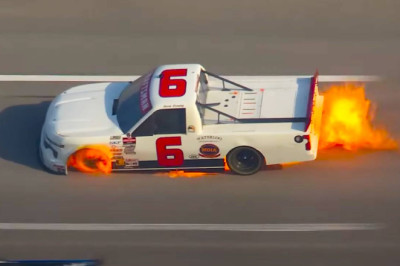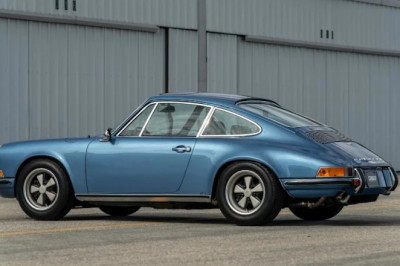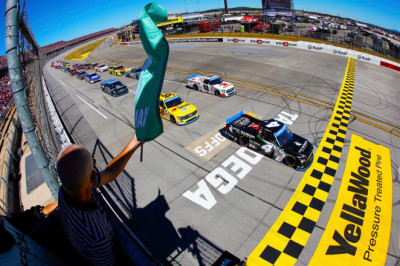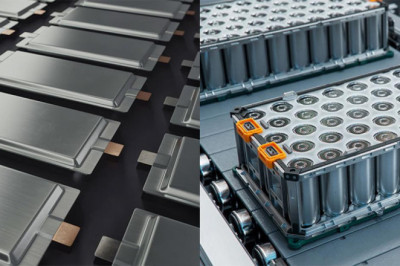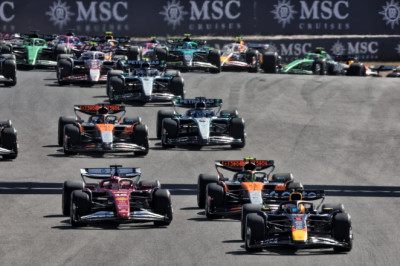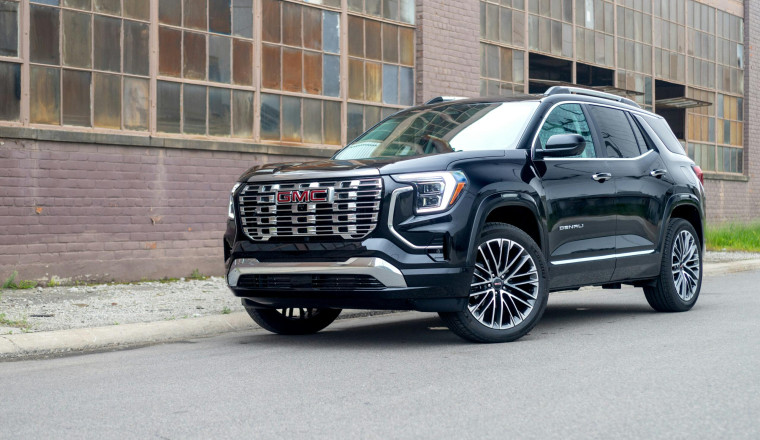
Dare I say it, the first GMC to wear the Denali name was revolutionary. The 1997 Yukon Denali concept wrote the formula for the Escalade, which has become a pop-culture icon and remains the most desirable Cadillac. In the meantime, every other GMC model has gained a Denali trim, even the entry-level crossover utility, the Terrain, in 2013. Now revamped for the Terrain’s third generation, the Denali lends a Professional Grade veneer to this crossover utility.
Much has changed for this new Terrain. As of the 2025 model year, it rides on a new platform. The Terrain moves from the Opel-engineered D2XX platform, which is now eleven years old, to GM’s new Vehicle Set Strategy “S” platform, which underpins the Terrain’s larger sibling at GMC, the Acadia, and its two cousins, the Chevrolet Traverse and Buick Enclave. It is slightly shorter and two inches wider than the 2018–2024 car and broadcasts a more truck-like persona. Though the Terrain also shares its new platform with the Equinox, as it once shared the D2XX, the GMC is no longer differentiated from the Chevrolet by a unique powertrain option. The 2025 Terrain is only available with the 175-hp, 1.5-liter turbocharged four-pot found in the Equinox.
In more encouraging news, the number of trims has shrunk from four to three, and they now have names rather than letters: The entry-level Terrain is called Elevation, which for 2025 is only available with front-wheel drive motivation ($31,295). For 2026, the Elevation will be available with all-wheel drive, a $2000 option. At the top end of the lineup is the luxurious Denali, which raises the price ceiling for the Terrain above $40,000, to $42,495. The off-road-ish AT4, a Terrain first, is only slightly less expensive than the Denali (at $39,995, the AT4 costs as much as the outgoing Denali did).
After a brief drive in a Downpour Blue-over-white Terrain Denali at a first-drive event hosted by GMC, we spent three days with this Denali loaner, which wore a $495 coat of black paint and the most expensive option on the Denali, a $1495 glass sunroof. It rang the register at $44,485.
The new styling ensures that no one will confuse the blocky GMC with the swoopy Buick Envision, the China-built CUV with which it will share a showroom. (The fanciest, most Denali-like trim is the Avenir. A 2026 model starts at $47,495.)
“Truckification” is a common theme in the CUV space these days—look how Chevy has redesigned its SUVs—and the Terrain’s boxy styling is a handsome foundation for the bechromed Denali trim, which boasts a set of 20-inch rims. They are the largest wheels ever fitted to a Terrain. GMC’s engineering team even told us that they made a different front cradle and used different dampers for this configuration to ensure that the 20-inch wheels met their standards for ride and handling. Together with the giant chrome DENALI badge on the tailgate—the trim level dwarfs the GMC logo—and the extensive chrome on the grille and the sills, the rims give the Terrain the street presence worthy of a Denali.
The interior is nearly the same story. All 2026 Terrains ditch the trapezoidal vents, black-plastic dials, and small, horizontal touchscreen of the previous generation. The redesigned dash is nearly straight across, with a rectangular screen behind the steering wheel where round gauges used to be, and a giant, high-resolution touchscreen leaning back against the dash, fringed at the bottom by a row of rubber-coated switches. The Denali ups the ante with trimmings of wood (real) and chrome (fake). The trim name replaces the brand name on the steering wheel. (You’ll also find DENALI embroidered onto the headrests and the passenger-seat carpet.) Our tester wore the more striking of the two upholstery options on the Denali—Light Ash Gray/Very Dark Atmosphere—and boasted the large sunroof (yes, it comes with a power-operated shade). The light gray upholstery and the generous light gave the cabin an airy, premium feel, compromised only by the contrasting, faux-leather material on the dash and steering wheel, which was dyed a very synthetic-looking color of cool brown.
The weakest point of the Denali package is the driveline. The turbocharged, 1.5-liter four-cylinder makes 175 hp, five more than the four-cylinder in the 2018–24 Terrain. However, because the one-five is now the only engine, the newest generation of Terrain is also the least powerful. Torque ratings vary with the transmission, and thus with trim level. Both transmissions appear to be shared with the Equinox: The CVT in the FWD version of the Elevation enables 184 lb-ft while the eight-speed auto in the AWD-only AT4 and Denali makes 203 lb-ft. The driveline options are perfectly acceptable for a CUV in the Terrain’s segment, but they are not Professional Grade.
The one-and-a-half-liter is easy enough to ignore if you never push it, but on Detroit’s infamously short on-ramps, where spirited merging is a survival tactic, the engine reveals itself as noisy and weak. We’d like more power for passing at speed—when you’re on the highway, for example, behind a car going 65 or 80, and need to accelerate into a lane where everyone’s zipping by near 80. The transmission is just as much to blame as the engine. Faced with that same highway scenario, the eight-speed is frustratingly slow to downshift.
The ride is a mixed bag. It is insulating, sure—we drove over old train tracks set into degrading concrete and were barely jostled in the nicely supportive chairs—but the gentlest maneuvers make the body pitch, roll, and dive, as if you’re trying to balance on a giant pillow. Though GM’s engineers used a damper design that allowed them to tune separately for high- and low-frequency inputs, we suspect that the 20-inch wheels threw a wrench in the equation. To add to the NVH woes, the tires make a lot of noise.
The new infotainment system is one of the Terrain’s stronger suits. Google runs the show for all modern GM infotainment systems, but the GMC user interface is, dare we say, more intuitive than that of Chevrolet or Cadillac. The display is very bright and its resolution is high. We didn’t notice wash-out or excessive glare. Like many infotainment systems today, the system rewards time spent logging into your favorite apps (Spotify, for example) using your smartphone. In the Terrain, and with any other vehicle with Google-backed infotainment, you’ll also want to log into your Google account to enable the most convenient features. Once you do, you can say “Hey Google, take me home,” and the car will plug your saved home address into the native Google Maps. (“Show gas stations near me” is another good one.)
If you have an iPhone and would like to take calls and send texts without CarPlay, the process requires more patience. If not, go ahead and use CarPlay—but know that, thanks to Google, automotive infotainment systems are becoming much more user-friendly, and some nearly close the gap to CarPlay.
At $45,000, there are more compelling options than the Terrain Denali. The market for compact crossovers is more crowded and competitive than ever, and 45 large can buy you a top-spec example from Toyota, Honda, or Mazda with a hybrid powertrain that not only gets close to 40 miles per gallon, compared to the FWD Terrain’s 27, but are more powerful (200+ hp). With a budget that generous, you’re even approaching the price of compact SUVs from luxury brands such as Mercedes or BMW. And we haven’t mentioned GM’s internal competition.
Though it is most closely related to the Equinox, the Terrain’s closest competitor—literally—will be the Buicks with which it will share showrooms. Most people who walk into a Buick-GMC dealer will be presented with the Terrain as the truck-ish alternative to the “car-like” Buick Envision. The comparison has merit, because the Envision is built on a car platform. More than ever, the new Terrain looks like the Sierra’s baby cousin, but its truck personality is only skin-deep. (You can’t tow more than 1500 pounds.) Plus, the Envision’s turbo-four makes more power and torque than the Terrain’s (up 53 hp and 55 lb-ft) and is paired with a nine- rather than eight-speed automatic. As of this writing, the Envision is the more attractive proposition: Buick is offering 0.9% APR, plus $1000 cash. Of course, you could buy an Equinox.
In short, GM has given its customers plenty of compact crossovers to choose between—perhaps a few too many.
The 2026 Terrain Denali is more fashionable than ever, with a modern, pleasant cabin and a handsome new suit. If you want the best that a Terrain has to offer, the Denali is the obvious choice. If you want the best compact crossover that GM has to offer, that answer is less clear.
Highs: One of GM’s most user-friendly infotainment systems, fashionable styling inside and out.
Lows: There’s just one engine, and it is neither a hybrid nor gutsy.
Takeaway: A Professional Grade veneer for GMC’s crossover utility.
I had a loaner of one of these. Nice model. While the drive line is at best adequate.
I hope GM restores the 2.0 option here to win my purchase. Since they enlarged the Arcadia Denali we no longer want one. This may be an options.
I also saw the AT5 Cadillac has been given more time. I may opt for it to replace our present car when it is time to trade.
I have no interest in the Hybrids. They cost more they are more expensive to up keep and if you have it when the battery is on the way out they can be very expensive to replace. You never save enough gas to cover it. Also resale on a bad Hybrid is horrible. Most have not experienced this yet but will in the next 10 years.
We have had Hybrids in at the shop and they are in need of some $$$ work. The owners then find trade on a Hybrid in need of work is not worth much.
Also avoid any CVT Transmission.






